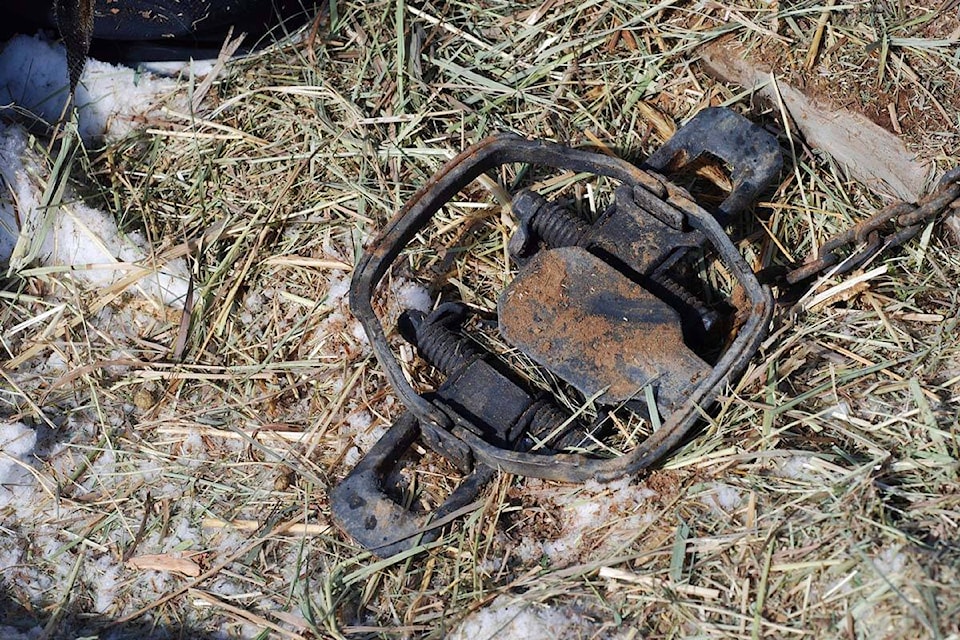A Kimberley, B.C. man had to jump into action to save his dog’s life in the winter of 2020, after the pooch got caught in a conibear hunting trap while tagging along with its owners on a cross-country ski.
Martin Brillings told a Black Press Media paper at the time he and his wife managed to use two spare leashes to cinch the trap springs down and free their dog, who was yelping in pain.
“The trap had closed on his neck and throat. He was in extreme distress and barely able to breathe. I have no doubt that in a few more minutes he would have asphyxiated. If the trap had closed a few inches forward it would have likely fractured his skull,” Brillings said.
That year, Brillings was one of 10 British Columbians whose cat or dog was caught in a wildlife trap, according to records obtained by wildlife-protection organization The Fur-Bearers through a Freedom of Information (FOI) request.
On average between 2015 and 2021, about 10.6 pets were trapped each year. Of them, 15 per cent died and 70 per cent were injured.
In total in the seven years, 66 dogs and eight cats were snagged. Incidents during that period were most frequent on Crown land (42), compared to private land (19) or unknown areas (13). The most dangerous times of year have been February, November, January and April.
When Brillings reported his dog’s close shave, he said the trap was only about 20 feet off the trail and baited with raw meat. He also noted there were no signs around to warn people it was an active trapping area.

READ ALSO: Kimberley resident warning dog owners to leash up after dog almost dies in conibear trap
Similar concerns are documented in B.C.’s records between 2015 and 2021. People regularly reported finding traps – bear traps, wolf traps, cougar traps, coyote traps, beaver traps and mouse traps – just off public roads or trails. A large proportion of people also noted that there were no signs or indicators that their pet may be at risk in the area.
The Fur-Bearers is calling on Canadian governments to change that.
The organization says there should be mandatory setbacks for traps set in or near public areas. For instance, it suggests a 1-kilometre setback from urban or suburban properties. The Fur-Bearers also says there should be a legal requirement for trappers to put signs up around their traps or snares.
To encourage accountability, the Fur-Bearers says these signs, as well as traps and snares, should include the trapper’s name and license number. The organization also says trappers should be required to report when domestic animals are caught in their traps, and governments should then have to make that data publicly available.
B.C.’s Ministry of Forests says it has already taken steps to protect pets by banning some traps within municipalities and implementing fines for people who set traps illegally or improperly. It says it’s considering other steps it could take to further protect pets, but offered no specifics in an email to Black Press Media.
Across Canada, B.C. has the highest rate of pets being caught in wildlife traps out of any other province or territory. The Fur-Bearers compared records from 2017 to 2021 and found B.C. had a total of 56 incidents, followed by Saskatchewan with 31, Alberta with 30, Manitoba with 24 and Quebec with 12. All other regions recorded fewer than 10 incidents over the five-year span, and data wasn’t provided from Ontario.
Because reporting isn’t mandatory anywhere in Canada, the Fur-Bearers estimates the actual number of incidents is far higher.
“The full scope of this problem is unknown,” the organization says in its report.
READ ALSO: Salmon Arm dog killed by coyote snare within city limits
READ ALSO: Shepherd chewed off foot to escape trap
@janeskrypnek
jane.skrypnek@blackpress.ca
Like us on Facebook and follow us on Twitter.
